11 Tiger-Striped Brindle Dog Breeds
Tiger stripes aren’t just for felines — they’re for dogs, too. Learn all about the canine breeds who can sometimes come with gorgeous brindle coats.
Tiger stripes aren’t just for felines — they’re for dogs, too. Learn all about the canine breeds who can sometimes come with gorgeous brindle coats.
by Jackie Brown, | December 30, 2024

Guillermo Velarde / Unsplash
It’s hard not to grow mesmerized with a brindle dog’s magnificently unique coat. Dogs with this brindle pattern display dark stripes and streaks over a lighter body color, much like a tiger’s stripes. Their coats — often a mix of black, red, fawn, and gray — come thanks to a certain gene. This gorgeous coat pattern can be found in many different dog breeds and mixes, giving you plenty of options to adopt a tiger dog of your own. (Here are a few name suggestions to get that dream going.)
From Pit Bulls to Plott Hounds to Whippets, brindle-coated dogs appear in a variety of shapes and sizes. And since many end up in shelters, finding the right brindle dog for you is relatively easy. Read on to learn more about them, from their unique coat features to their countries of origin.
Brindle is not a breed itself, but a color pattern. Lots of dogs come in the brindle pattern, including mixed-breed dogs and many purebred dogs. Some breeds who commonly come in brindle include the following.

Xavier Montero Llorens / iStock
The American Pit Bull Terrier (and their mixes) comes in many colors, including brindle. These muscular, athletic dogs trace their roots back to fighting dogs who were developed from Bulldogs and Terriers. The breed later transformed into gentle, friendly, loyal family dogs.
Origin: United Kingdom
Height: 17 to 22 inches
Weight: 30 to 66 pounds
Coat type: Short, glossy, and smooth
Lifespan: 8 to 16 years
Browse for American Pit Bull Terriers (and their mixes) for adoption

Jose Coello / Stocksy
Boxers (and their mixes) come in fawn and brindle, which can manifest in several shades, from sparse stripes on a fawn background to dark brindle. Boxers have performed lots of different jobs, including police and military work, but their loyal and affectionate personalities make them incredible family dogs.
Origin: Germany
Height: 21.5 to 25 inches
Weight: 50 to 80 pounds
Coat type: Short, shiny, and smooth
Lifespan: 10 to 12 years
Browse for Boxers (and their mixes) for adoption

The Cane Corso comes in several colors, all of which can be brindled. Also known as the Italian Mastiff, the Cane Corso was originally a war dog. Later, the breed was used as guard dogs, farm dogs, and to hunt wild boar.
Origin: Italy
Height: 23.5 to 27.5 inches
Weight: 85 to 110 pounds
Coat type: Short, stiff, and shiny
Lifespan: 9 to 12 years
Browse for Cane Corsos (and their mixes) for adoption

Tanya / AdobeStock
The brindle pattern is not only seen in purebred dogs. Whether you like fawn brindle dogs or brown brindle dogs, you can find this pretty pattern in mixed-breed dogs of all shapes, sizes, and coat types. In fact, adopting a brindle dog presents several aesthetic and personality advantages to better mesh with your pet-parent preferences.
Origin: Worldwide
Height: 5 to 30 inches
Weight: 5 to 190 pounds
Coat type: Wiry, smooth, rough, double, curly, wavy, silky
Lifespan: 8 to 18 years
Browse for Mutts (and their mixes) for adoption

The Bullmastiff (and their mixes) comes in red, fawn, or brindle. This giant breed was originally developed to be an estate watchdog, a job at which Bullmastiffs excelled. They are also prized for their loyalty and calm temperament, making them wonderful buddies.
Origin: England
Height: 24 to 27 inches
Weight: 100 to 130 pounds
Coat type: Short and dense
Lifespan: 7 to 9 years
Browse for Bullmastiffs (and their mixes) for adoption

Three Dogs photography / Shutterstock
The Dutch Shepherd is a medium-sized brown brindle dog with a sturdy, athletic build. Working dogs through and through, Dutch Shepherds have the energy and stamina to excel as all-purpose farm dogs, a job they still do today.
Origin: The Netherlands
Height: 21.5 to 24.5 inches
Weight: 42 to 75 pounds
Coat type: Long, short, or rough
Lifespan: 11 to 14 years

French Bulldogs can have sparse or heavy brindle markings on any of the three colors they come in (white, cream, and fawn). Known for their large “bat ears,” Frenchies were bred down from their larger cousin the Bulldog. They are companion dogs, providing love and affection to their favorite people.
Origin: France
Height: 11 to 13 inches
Weight: Less than 28 pounds
Coat type: Short and smooth
Lifespan: 10 to 12 years

Sergey Tikhomirov / Alamy Stock Photo
Basenjis come in several colors, including brindle, often with white markings on their face, neck, and legs. The Basenji is called the “barkless dog,” because they don’t bark in the traditional sense — although they make a variety of sounds, including yodels. Basenjis were once used as hunting dogs in their native Africa, and are, today, known for being intelligent and graceful.
Origin: Africa
Height: 16 to 17 inches
Weight: 22 to 24 pounds
Coat type: Short and fine
Lifespan: 12 to 14 years
Browse for Basenjis (and their mixes) for adoption

NA Creative Studio / Shutterstock
The Great Dane is one of the largest and tallest dog breeds. Despite their name, this breed is not from Denmark. In its country of origin, Germany, the Great Dane is called the Deutsche Dogge (German Mastiff). Great Danes are people-oriented dogs who thrive on companionship.
Origin: Germany
Height: 28 to 32 inches tall
Weight: 110 to 175 pounds
Coat type: Short, thick, and smooth
Lifespan: 7 to 10 years
Browse for Great Danes (and their mixes) for adoption

DaveWalker / Shutterstock
The Plott Hound is almost always brindle, though the brindle pattern is displayed on backgrounds of a wide variety of colors. The Plott Hound is from Louisiana, where the breed is still treasured today as an outstanding tracking dog.
Origin: United States
Height: 20 to 25 inches tall
Weight: 40 to 60 pounds
Coat type: Smooth, fine, and glossy
Lifespan: 12 to 14 years
Browse for Plott Hounds (and their mixes) for adoption

stylefoto24 / Shutterstock
The Whippet looks like a small Greyhound, something that is not surprising since they were bred down from their larger cousins sometime during the 1800s. Whippets are sighthounds, which means they use their speed and excellent sense of sight to chase down prey. They are also loving family dogs.
Origin: England
Height: 18 to 22 inches tall
Weight: 25 to 40 pounds
Coat type: Short and smooth
Lifespan: 12 to 15 years
Browse for Whippets (and their mixes) for adoption
Brindled dogs can have a variety of base colors, including blue (light gray) or red (red fawn or mahogany), and you’ll even see brindles in white dogs. There are two types of brindle coat variations: traditional and reverse.
Traditional brindle dogs have black or dark-brown stripes over brown, fawn, tan, or cream.
In reverse brindle dogs, the pattern is switched: The base color is darker and the stripes are lighter.
The cause of brindle coloring in dogs lies in specific genetic factors that turn on the expression of a tiger-stripe pattern in dogs that carry these genes. Brindle dogs have one gene for black or dark pigment, and another gene for red or yellow color. A gene called K locus is the key factor in triggering the brindle striping.
If you’re searching for a new dog or puppy, consider adopting brindle dog who comes with a truly unique coat. To get started, Adopt a Pet will let you customize your search by color, breed, sex, and age — so you can find a pup who fits your lifestyle and preferences.
It could be that people are drawn to more common colors or patterns, or that lighter dogs stand out more, but no one knows for sure. Some studies have found that brindle dogs take a longer time to be adopted than dogs of lighter colors (a similar issue is observed with black dogs).
No, brindle is not a breed of dog. It’s a color pattern that creates dark stripes atop a lighter fur color. Brindle is seen in many different dog breeds, as well as mixed-breed dogs.
No, not all dog breeds have brindle coats. Some dog breeds are never brindle (according to their breed standards), others are always brindle, and others can be brindle or another color or pattern.
Brindle is caused by a dominant gene. A dog only needs to have one copy of this gene to be brindle or to pass brindle on to their puppies.
No, there aren’t any health issues associated with brindle coats. Brindle dogs might be prone to genetic diseases that appear in their breed, but these are not linked to the brindle coat pattern.
“Dominant Black (K Locus) | Veterinary Genetics Laboratory.” Vgl.ucdavis.edu, vgl.ucdavis.edu/test/dominant-black.
Williams, Krista. “Genetics Basics - Coat Color Genetics in Dogs.” Vca_corporate, 2009, vcahospitals.com/know-your-pet/genetics-basics-coat-color-genetics-in-dogs.

Jackie Brown lives in sunny Orange County, CA, where she works as a freelance writer and editor. When she’s not on deadline, you can find her paddling her outrigger canoe in the Pacific Ocean or hiking in the foothills with her miniature poodle and two young boys.
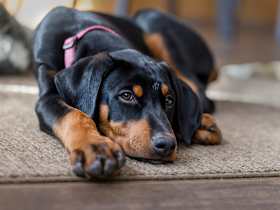
Breed Info

Breed Info
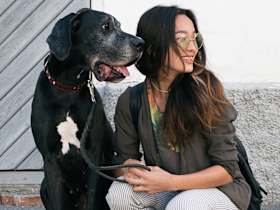
Breed Info
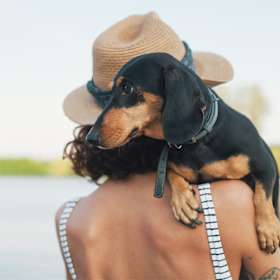
Breed Info
From bloodhounds to beagles, here's what to expect when you bring home a hound.
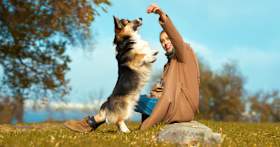
Breed Info
Looking for an intelligent pup? You’ve come to the right place.
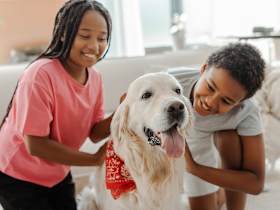
Breed Info
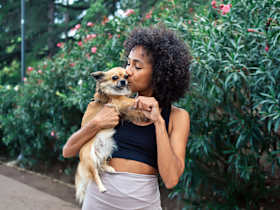
Breed Info
Here’s what happens when you combine the feisty spunk of Chihuahuas with other breeds.
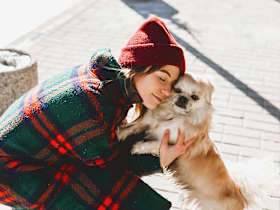
Breed Info
These mellow pups are here to match your homebody energy.

Breed Info
From cuddly companions to vigilant defenders, meet the dogs who do it all.